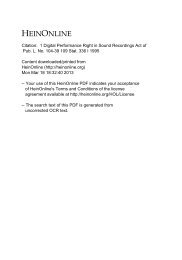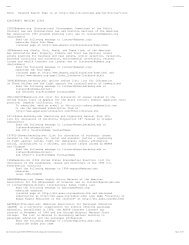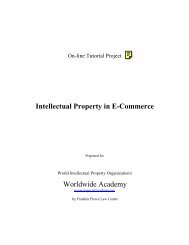BIEDERMANN MOTECH GMBH and Depuy Spine, Inc, Plaintiffs
BIEDERMANN MOTECH GMBH and Depuy Spine, Inc, Plaintiffs
BIEDERMANN MOTECH GMBH and Depuy Spine, Inc, Plaintiffs
Create successful ePaper yourself
Turn your PDF publications into a flip-book with our unique Google optimized e-Paper software.
appropriate for a court to "rely heavily" on the specification for guidance during claim construction. Id. at<br />
1317.<br />
It is also possible that the inventors intentionally excluded some embodiments by what they wrote in the<br />
patent specification. For instance, the inventors may have said "the invention is X" or "the invention has X"<br />
or "the invention does X." In such a situation, the inventors will be held to their word <strong>and</strong> will not be<br />
permitted to retract what they said in the specification. Chimie v. PPG Indus., 402 F.3d 1371, 1379<br />
(Fed.Cir.2005). That is, if the inventors have limited the scope of their invention in the specification, then<br />
what they said is "dispositive" during claim construction. Phillips, 415 F.3d at 1316.<br />
The doctrine of claim differentiation is one of the main tools for claim construction. There are two types of<br />
claim differentiation: the differentiation between an independent claim <strong>and</strong> a claim which depends from it,<br />
<strong>and</strong> the differentiation between two independent claims. In either case, claim differentiation comes into play<br />
when a claim construction would render additional, or different, language in another independent claim<br />
superfluous.<br />
The former type of claim differentiation refers to the presumption that an independent claim should not be<br />
construed as having the same scope as a dependent claim. Curtiss-Wright Flow Control Corp. v. Velan, <strong>Inc</strong>.,<br />
438 F.3d 1374, 1380-81 (Fed.Cir.2006). For example, suppose an independent claim recites an element (like<br />
an engine), <strong>and</strong> there is a claim which depends from the independent claim which does nothing but recite<br />
language which limits that element to a species (for example, to a rocket engine). Then one could infer,<br />
under the doctrine of claim differentiation, that the word "engine" was deliberately chosen to encompass<br />
other types of engines besides rocket engines. A similar principle applies if the dependent claim merely<br />
recites an added element (like a pressure jacket) totally absent from the independent claim. In such a<br />
situation it would likely be improper to interpret the parent claim so that it included the dependent claim's<br />
added element. Liebel-Flarsheim Co. v. Medrad, <strong>Inc</strong>., 358 F.3d 898, 909-10 (Fed.Cir.2004).<br />
The latter type of claim differentiation is a presumption that each claim in a patent has a different scope. It<br />
can apply, for instance, between two independent claims or between an independent claim <strong>and</strong> a claim<br />
which depends from a different independent claim. This presumption is not as strong as the claim<br />
differentiation between an independent claim <strong>and</strong> a claim which depends from it; it is more of a guide than<br />
a rigid rule. "Different claims with different words can, of course, define different subject matter within the<br />
ambit of the invention. On the other h<strong>and</strong>, claim drafters can also use different terms to define the exact<br />
same subject matter. Indeed [the Federal Circuit] has acknowledged that two claims with different<br />
terminology can define the exact same subject matter." Curtiss-Wright Flow Control Corp. v. Velan, <strong>Inc</strong>. .,<br />
438 F.3d 1374, 1380-81 (Fed.Cir.2006).<br />
A related third principle is that words in claims should be interpreted to not render other parts of the same<br />
claim superfluous. Merck & Co. v. Teva Pharms USA, 395 F.3d 1364, 1372 (Fed.Cir.2005). In one case, the<br />
district court was overruled specifically because the district court had interpreted the word "adjustable" to be<br />
so broad as to make it meaningless. Curtiss-Wright Flow Control Corp. v. Velan, <strong>Inc</strong>., 438 F.3d 1374, 1379<br />
(Fed.Cir.2006). Claims should be constructed so that each word in the claim has meaning. Bicon, <strong>Inc</strong>. v.<br />
Straumann Co., 441 F.3d 945, 950 (Fed.Cir.2006). See also In re Wilson, 57 C.C.P.A. 1029, 424 F.2d 1382,<br />
1385 (C.C.P.A.1970) ("All words in a claim must be considered in judging the patentability of that claim<br />
against the prior art.").<br />
The Federal Circuit has admonished that claim differentiation is not the be-all <strong>and</strong> end-all, sole tool for






